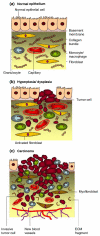Cancer and the tumor microenvironment: a review of an essential relationship
- PMID: 19083000
- PMCID: PMC2858592
- DOI: 10.1007/s00280-008-0881-9
Cancer and the tumor microenvironment: a review of an essential relationship
Abstract
Purpose: The role of the microenvironment during the initiation and progression of carcinogenesis is now realized to be of critical importance, both for enhanced understanding of fundamental cancer biology, as well as exploiting this source of relatively new knowledge for improved molecular diagnostics and therapeutics.
Methods: This review focuses on: (1) the approaches of preparing and analyzing secreted proteins, (2) the contribution of tumor microenvironment elements in cancer, and (3) the potential molecular targets for cancer therapy.
Results: The microenvironment of a tumor is an integral part of its physiology, structure, and function. It is an essential aspect of the tumor proper, since it supplies a nurturing environment for the malignant process. A fundamental deranged relationship between tumor and stromal cells is essential for tumor cell growth, progression, and development of life threatening metastasis. Improved understanding of this interaction may provide new and valuable clinical targets for cancer management, as well as risk assessment and prevention. Non-malignant cells and secreted proteins from tumor and stromal cells are active participants in cancer progression.
Conclusions: Monitoring the change in the tumor microenvironment via molecular and cellular profiles as tumor progresses would be vital for identifying cell or protein targets for cancer prevention and therapy.
Figures

References
-
- World Health Organization 2006
-
- Hanahan D, Weinberg RA. The hallmarks of cancer. Cell. 2000;100(1):57–70. - PubMed
-
- Kuper H, Adami HO, Trichopoulos D. Infections as a major preventable cause of human cancer. J Intern Med. 2000;248(3):171–183. - PubMed
-
- Kalluri R, Zeisberg M. Fibroblasts in cancer. Nat Rev Cancer. 2006;6(5):392–401. - PubMed
Publication types
MeSH terms
Substances
Grants and funding
LinkOut - more resources
Full Text Sources

